Indigenous Placemaking
Placemaking is a term used to describe creating unique, iconic spaces of gathering for learning, teaching and exchange that embody Indigenous culture and traditions and strengthens the connection between public space and the people who use it. Below, explore Indigenous placemaking initiatives supported by the Indigenous Space Sub-Working Group and other groups from across the university that have collaborated to bring Indigenous art, culture and ways of life to our campus.
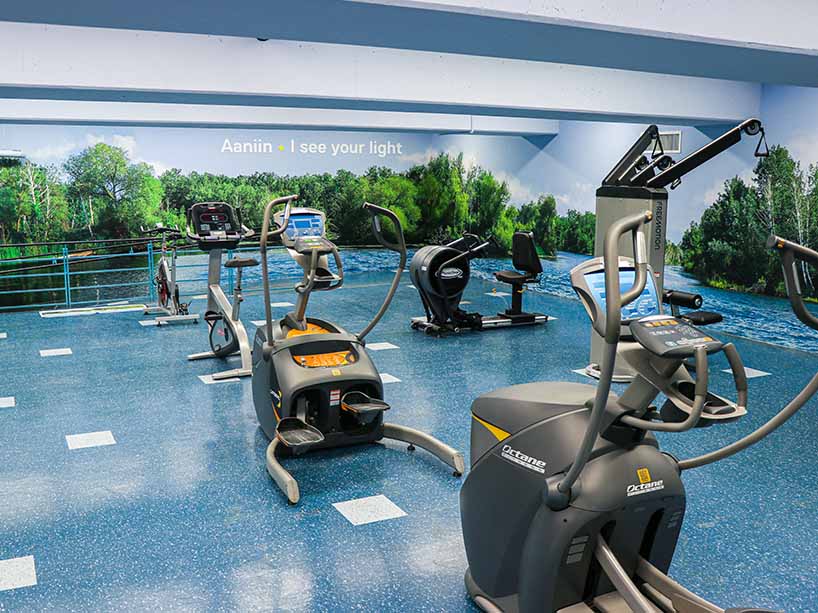
(Photo: Mark Samy)
Artist
Anishinaabe artist Caroline Brown from Teme-Augama Anishinabai (People of the Deep Water), Whitebear family, Loon clan and Temagami First Nation. Photography by Natalia Dolan (Image Arts, ‘08).
Description
An immersive space displaying floor-to-ceiling nature imagery. Inspired by Taddle Creek, which once flowed beneath the Recreation and Athletic Centre’s (RAC) location, it pays homage to the land's history and First Nations inhabitants. The space celebrates nature's gifts while maintaining an untouched quality, as Brown and Dolan photographed during a pontoon excursion to the Toronto Islands around sunset. The resulting images were seamlessly stitched together, enveloping the room in a panoramic display.
Location
First Nations Immersive Space, Recreation and Athletic Centre (RAC), cardio and strength circuit room. All students and members must tap their OneCard at the turnstiles to enter the RAC facilities.
Acknowledgements
This piece was created in collaboration between Athletics and Recreation and the Indigenous Space Sub-Working Group (ISSWG).
Learn more
To learn more about this piece, read the TorontoMet Today article.
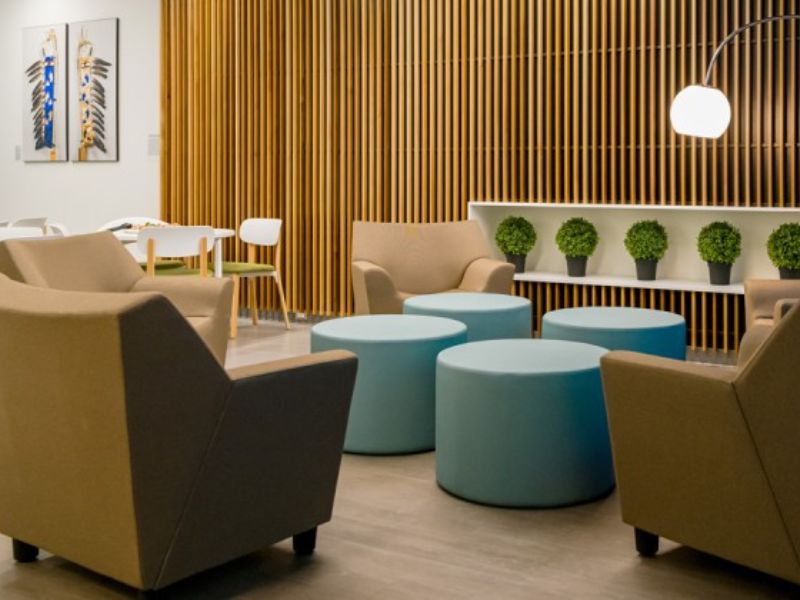
Description
The Staff and Faculty Wellbeing Lounge provides a space for employees to connect, socialize and eat, as well as to rejuvenate and rest. Along with dining and food preparation spaces, the lounge offers a space with armchairs and ottomans, and a rest area with loungers and customizable lighting.
As part of TMU’s ongoing work to Indigenize our campus, one of the priorities for the design of the lounge was to include Indigenous elements throughout. The lounge’s name, provided by TMU Elder Joanne Dallaire, is pronounced “ah-new-weh-peek-ah-mik” and is a Cree name meaning “a safe place to rest”.
Location
Podium building, POD 156. Staff and faculty can access the lounge with their OneCard.
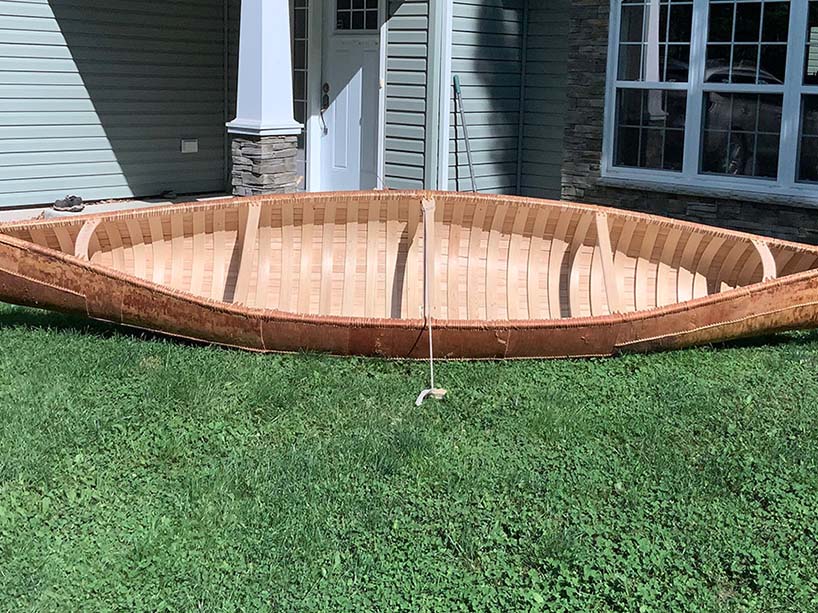
(Photo: Todd and Melissa Labrador)
Artist
Todd Labrador, Mi'kmaq artisan.
Description
Ted Rogers School of Management welcomed a birch bark canoe from Todd Labrador during a ceremony at the 2022 Reconciliation in Business Conference. The canoe was accepted into the Treaty 13 territory by R. Stacey LaForme, Chief of the Mississaugas of the Credit First Nation. Construction of the canoe started June 24, 2021, and was finished September 5, 2021 with work conducted four days a week throughout the process. The canoe is made of 700+ feet of spruce roots that were harvested and split, 38 cedar canoe ribs and canoe gunwales, and harvested birch bark and collected hardwood used for the wooden pegs.
Location
TRSM, 9th floor (TRS 30172).
Learn more
Learn more about the Birchbark Canoe building process on TRSM’s Indigenous Art Installation website.
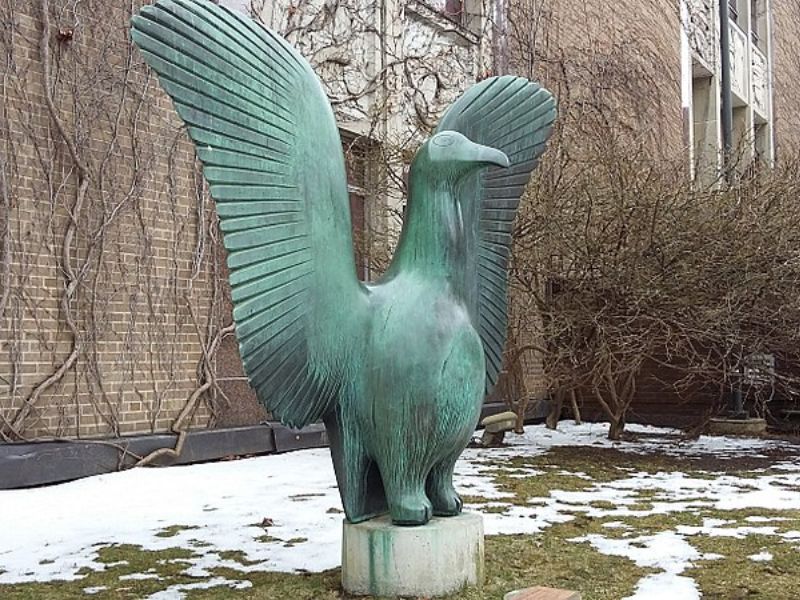
Artist
Abraham Etungat, Inuit from Baffin Island.
Description
This bronze bird stretching its wings in TMU’s quad measures at seven feet tall, has a wingspan of over eight feet and weighs more than 1,000 pounds. The sculpture is one of four copies of a small soapstone carving by Inuit artisan Abraham Etungat that were commissioned in the 1970s by the Devonian Group, a charitable foundation based in Calgary that underwrites public art installations, parks and historic preservation projects. The other three are located at Connaught Park in Calgary, at Robson Square in Vancouver and the Art Gallery of Nova Scotia in Halifax.
Location
TMU quad, west side, open to the public.
Learn more
Learn more about the Bird of Spring and its complex history through TMU Archives and Special Collections.
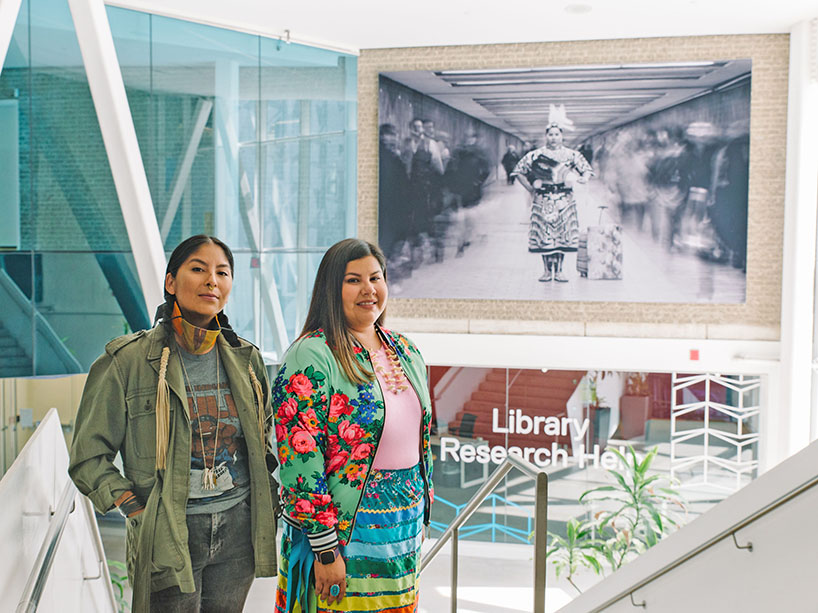
(Photo: Stef and Ethan)
Artist
Nadya Kwandibens, Anishinaabe (Ojibwe) from the Animakee Wa Zhing #37 First Nation in Northwestern Ontario.
Description
Artist Nadya Kwandibens photographed this 10 x 15.7-foot black-and-white portrait of dancer Tee Lyn Duke inside a Toronto subway station in 2010. This piece is part of herConcrete Indians series, which reflects on contemporary Indigenous identity. Collaborating with subjects who volunteer their participation, Kwandibens explores what urbanization means for Indigenous Peoples across Turtle Island and how living in urban areas can affect one’s cultural identity.
Location
Student Learning Centre/west entrance to the Libraries. TMU community members can access the SLC with their OneCard.
Acknowledgements
Support for this piece was made possible by the University Library in collaboration with the Indigenous Space Sub-Working Group (ISSWG).
Learn more
To learn more about the Concrete Indians series and this art piece read the TorontoMet Today article.
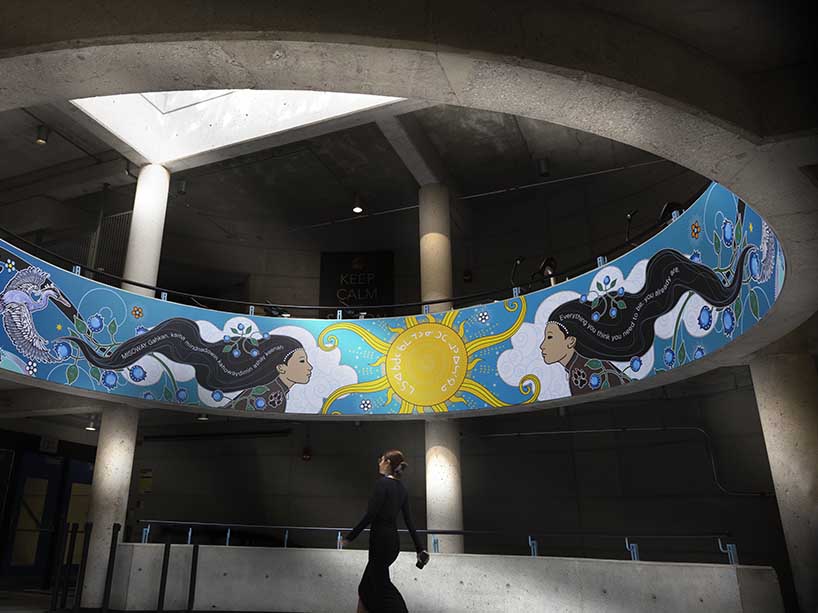
(Photo: Caroline Brown)
Artist
Caroline Brown, Anishinaabe artist, Teme-Augama Anishinabai (People of the Deep Water), Whitebear family, Loon clan and Temagami First Nation. Design developed with Joanne Dallaire, Senior Advisor, Indigenous Relations and Reconciliation.
Description
In this mural located in the north rotunda of TMU’s Recreation and Athletic Centre, two people face each other in reflection, with reassurance. They lead us with a Wolf Clan Paw Print design on their shoulders, a nod to the Wolf Clan. From left to right the first words are in Cree, entwined in the left person’s hair, and Cree syllabics within the beaded sun and then the English words, wrapped in the right person’s hair, “everything you think you need to be, you already are.”
The skylight brings changing natural light onto the images, with drifting leaf shadows and birds flying overhead. The physical space adds to the symbolism and the circle holds everything together with continuity: sunrise to moonrise, day into night, moon and stars, sun and clouds, earth, water and sky–heron, deer, fish and loon–nature in harmony, motion and stillness.
Location
North rotunda of TMU’s Recreation and Athletic Centre (RAC). All students and members must tap their OneCard at the turnstiles to enter the RAC facilities.
Learn more
To learn more about this artwork read the TorontoMet Today article.
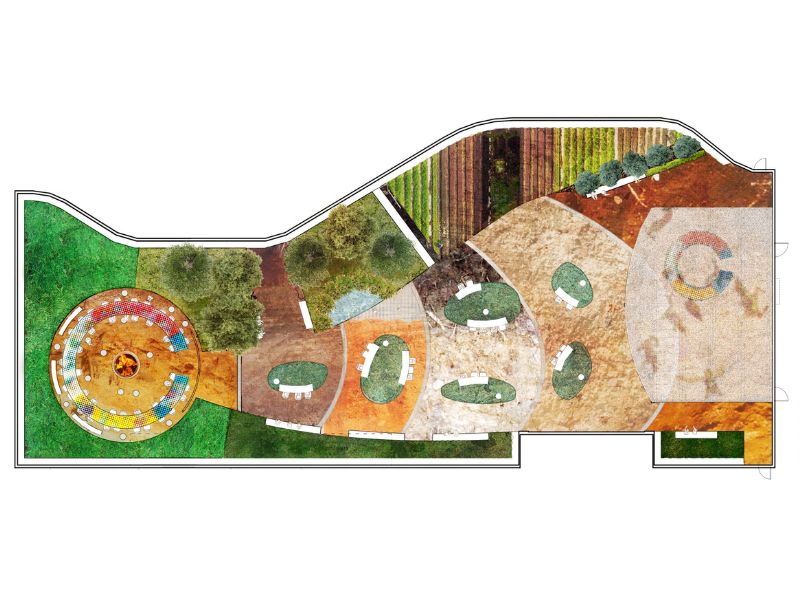
(Rendering: Indigenous design team)
Designers
The Indigenous design team is led by Sheila Boudreau (Principal, SpruceLab (external link) ) with Gary Pritchard (external link) (4 Directions of Conservation), Terence Radford (Trophic Design (external link) ), Eladia Smoke (Smoke Architecture (external link) ), and Jane Hayes (Garden Jane (external link) , and Hoffman Hayes (external link) ). Special advisors include Dr. Diana Beresford-Kroeger (external link) , Dr. Angela Mashford-Pringle (external link) , and Jeremy Wright (ZinCo (external link) ).
Description
The Indigenous Healing Garden is currently in development and will be an almost 12,000 sq ft. courtyard located in the Ted Rogers School of Management. The structure of the garden and the elements within are formed with organic shapes and natural materials. The garden is made with the hopes of creating a comfortable, safe and peaceful environment where those who visit it can connect with water, plants and nature. The design responds to the importance of being involved with the land, as the garden welcomes the growing of food for the cafe, herbs, medicines and plants for traditional crafts and ceremony and provides home for various plant species. The garden will also honour the Eastern Door, which is of great respect to the Anishinaabeg, the First Nations Treaty Rights Holders of Toronto (Mississaugas of the Credit First Nation, Treaty 13, and the Williams Treaties First Nations to the east).
Location
Ted Rogers School of Management (TRSM), 7th floor courtyard.
Learn more
To learn more about the garden visit the TRSM Indigenous Initiatives web page.
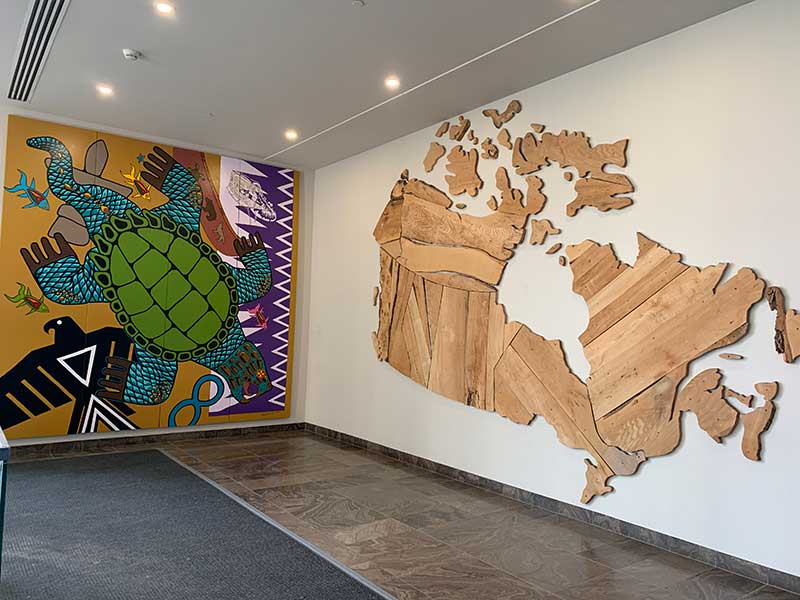
Artist
Philip Cote, Moose Deer Point First Nation (Young Spiritual Elder, activist, educator, cultural interpreter and historian)
Description
This mural is a vibrant tribute to the Indigenous communities and ancestral history of Turtle Island, incorporating culturally significant symbols and motifs that visually speak to the Indigenous nations presently on this land. It features:
- A snapping turtle, representing Turtle Island.
- Fish representing Indigenous intellect and the underworld.
- The Thirteen Moon Calendar representing the land.
- An Anishinaabe moccasin, the present-day symbol of the Mississaugas of the Credit First Nation, whose traditional territory is where the Ted Rogers School of Management is situated.
- The Tadadaho belt, signifying the Great Peace among the Five Nations—Onodaga, Cayuga, Seneca, Oneida, Mohawk—later joined by the Tuskarora, which today are collectively recognized as the Six Nations.
- The thunderbird, honouring the Three Fires Council, an alliance of the Ojibwe with the Potawatomi and Odawa Nations.
- The canoe with animal silhouettes, representing the Wendat, Neutral and Petun peoples.
- The Inuksuk with a blue star, recognizing the Inuit.
- The blue infinity symbol, recognizing the Métis.
Created in partnership with Moccasin Identifier (external link) , the mural honours the Indigenous land on which the Ted Rogers School community gathers to learn, teach and grow.
Location
Ted Rogers School of Management (TRSM), the landing beneath the 7th floor.
Acknowledgements
This art installation was made possible in partnership with the Moccasin Identifier.
Learn more
Learn more about the ‘Indigenous History of the Land’ mural (external link) .
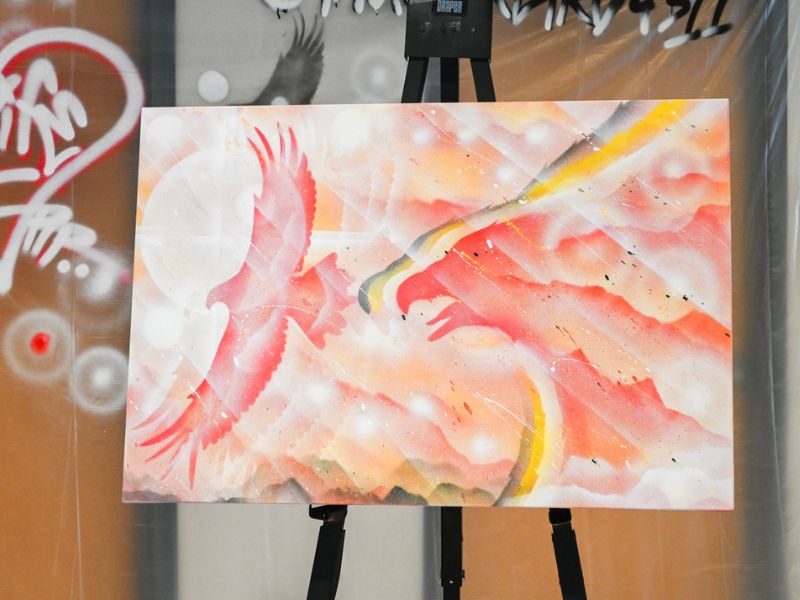
(Photo: Tiffany Chan)
Artist
Peatr Thomas (external link) , Ininew and Anishinaabe multidisciplinary artist.
Description
Peatr Thomas was a live artist and guest at the inaugural Reconciliation in Business Conference held at the Ted Rogers School of Management on September 25, 2022. Painted on the conference floor, Peatr Thomas delivered his artwork in support of the Toronto Council Fire Native Cultural Centre.
Location
Ted Rogers School of Management, 9th floor (TRS 30172).
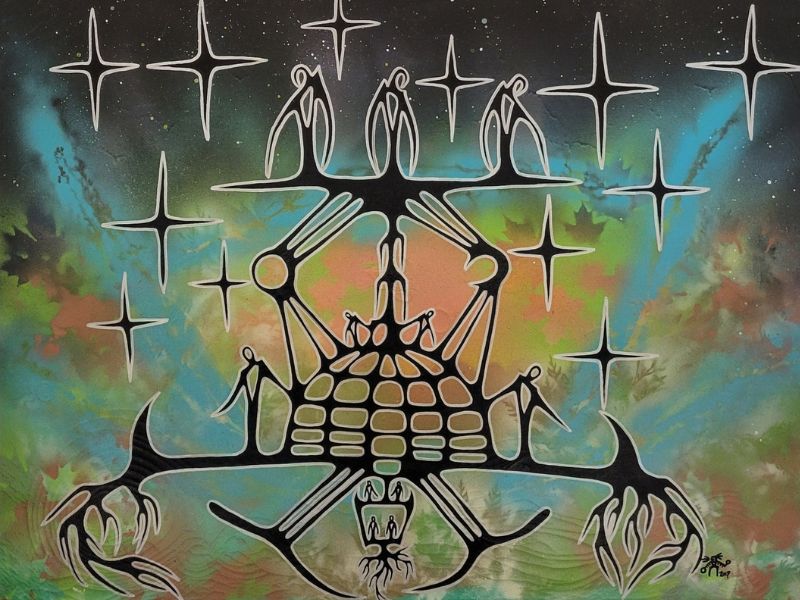
Artist
Nyle Miigizi Johnston (external link) , Chippewas of Nawash Unceded First Nation.
Description
Since December 2018, the main Student Affairs space on campus has featured a piece of artwork by Anishinaabe artist Nyle Miigizi Johnston. The painting is themed around protection and healing.
Location
Student Affairs, Podium building, POD 60.
Learn more
For more information about the painting told from Johnston’s perspective, you can watch this video (external link) .
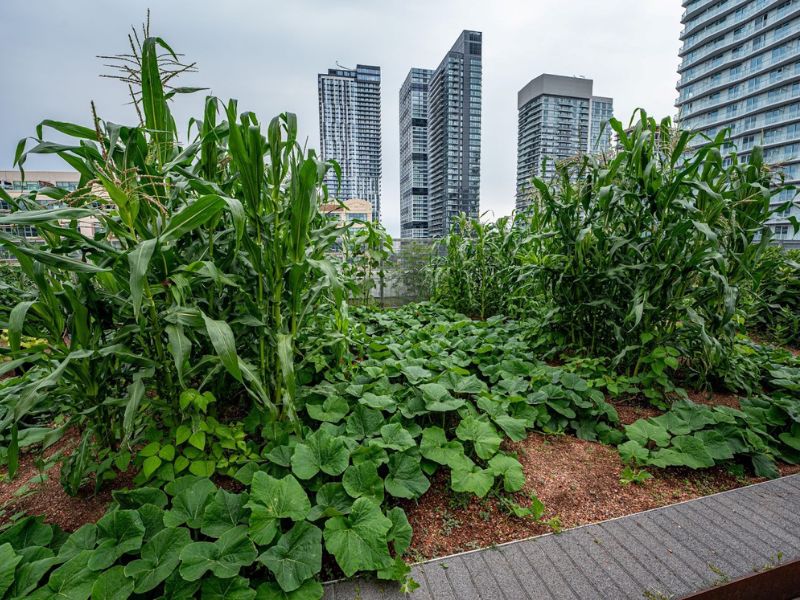
Description
The Indigenous Foodways program supports and celebrates traditional Indigenous ecological knowledge and ways of growing, while also producing crops and medicines for the TMU community.
The Urban Farm and Indigenous Foodways program uses an Indigenous-inspired distribution system known as the “model of thirds,” where no less than one third of food is donated to the community, one third is sold at subsidized rates for students, and no more than one third is sold at market rate. The Medicine Garden grows Indigenous medicines using traditional growing methods including sage, tobacco, sweetgrass, juniper and more.
Location
Daphne Cockwell Health Sciences Complex (DCC) rooftop, 8th floor. Access is restricted.
Learn more
Learn more about the Indigenous Foodways program.
Contact
The Urban Farm and Samantha Williams Barrantes, Indigenous-Led Programs Coordinator, at swilliamsbarrantes@torontomu.ca.
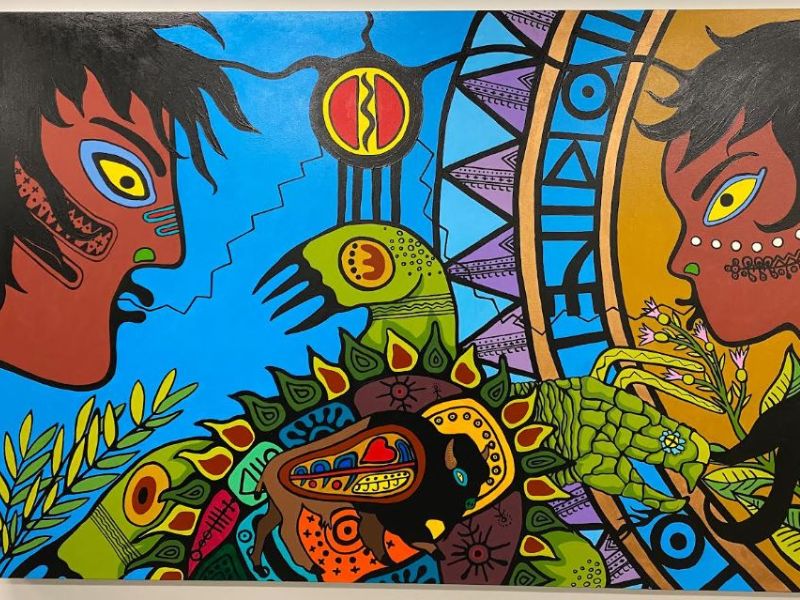
(Photo: Alyssa K. Faoro)
Artist
Philip Cote, Moose Deer Point First Nation.
Description
The painting depicts a man and woman face-to-face, with a power symbol above them–a turtle in the middle and a bison on its back. The yellow in the east and the black in the west represent life and death with the turtle in the center representing Turtle Island. The theme of the art is inspired by the medicine wheel, which symbolizes teaching of health and healing.
Location
Sally Horsfall Eaton Centre for Studies in Community Health, Faculty of Community Services, 6th floor.
Acknowledgements
Lynn Lavallée, an Anishnaabe registered with the Métis Nation of Ontario and the strategic lead of Indigenous resurgence in the Faculty of Community Services, helped organize Philip Cote’s artwork installation.
Learn more
To learn more about the Morning Star at the Eastern Doorway mural read the TorontoMet Today story.
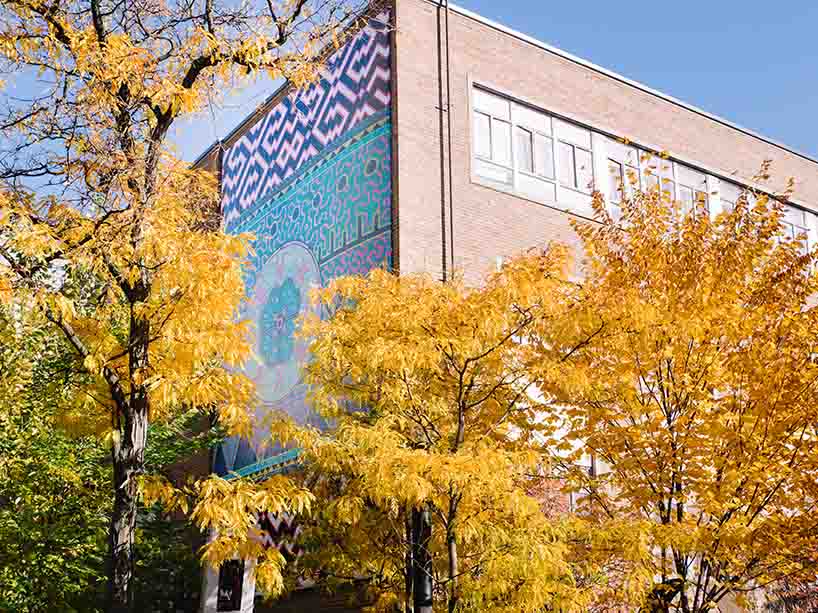
(Photo: Stef and Ethan)
Artists
Niap (Nancy Saunders) from Kuujjuaq, Nunavik, Quebec and Olinda Reshinjabe Silvano from Lima, Peru.
Description
This mural is part of Arctic/Amazon: Networks of Global Indigeneity (external link) , an expansive curatorial program originated by the Wapatah Centre for Indigenous Visual Knowledge.
Spanning 12-by-8 metres, the mural merges traditions, cultural legacies and insights from the Arctic and Amazon regions through the exploration of Indigenous ways of being, seeing and the shared values that inform each artist’s work. The colour scheme of the mural embodies the ice, northern lights, Inuit cosmologies and symbolism of the North; while the bold graphics of ancient kené designs symbolize woven visualizations of plant songs that serve as a musical score for Shipibo-Konibo peoples of the Amazon.
Location
Gould St. and Victoria St., located on the west-facing wall of Kerr Hall West at Gould Street and Nelson Mandela Walk.
Acknowledgements
Support for the mural was made possible with the generous support from the university, StreetARToronto, a City of Toronto program; Canada Council for the Arts; Nunavut Community Tourism and Cultural Industries; the Ontario Arts Council; Downtown Yonge Business Improvement Area; Partners in Art; and the Toronto Arts Council.
Learn more
To learn more, read the TorontoMet Today story.
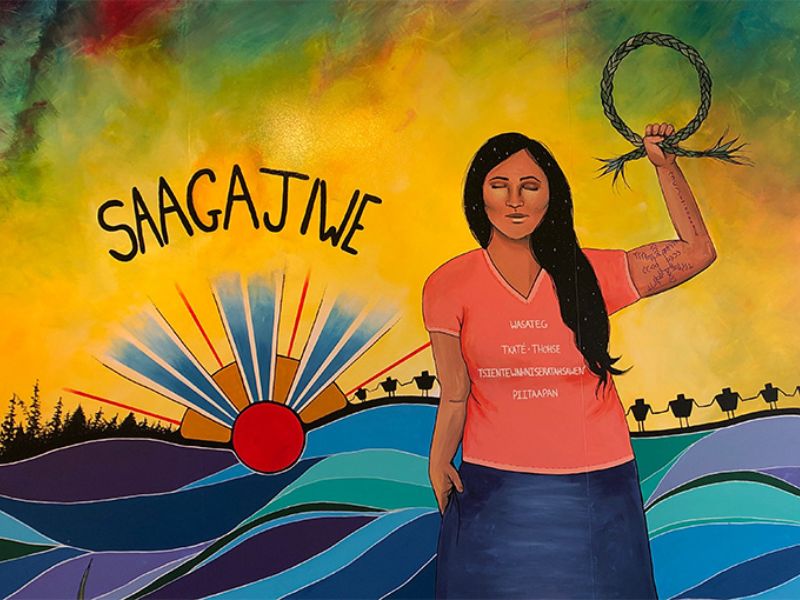
Artists
Co-created by Mo Thunder, Edan Maxam and Animikiikotcii Maakaai.
Description
A mural featuring a woman in the foreground holding sweetgrass, and a hill-like landscape with figures holding hands in the background. The Saagajiwe logo symbolizes “emerging light of dawn” which means light, warmth, love and care for each other and the land.
Location
Rogers Communication Centre (RCC) 2nd Floor, The Creative School.
Learn more
To learn more about the mural visit the Saagajiwe website and watch the Saagajiwe creation video (external link) .
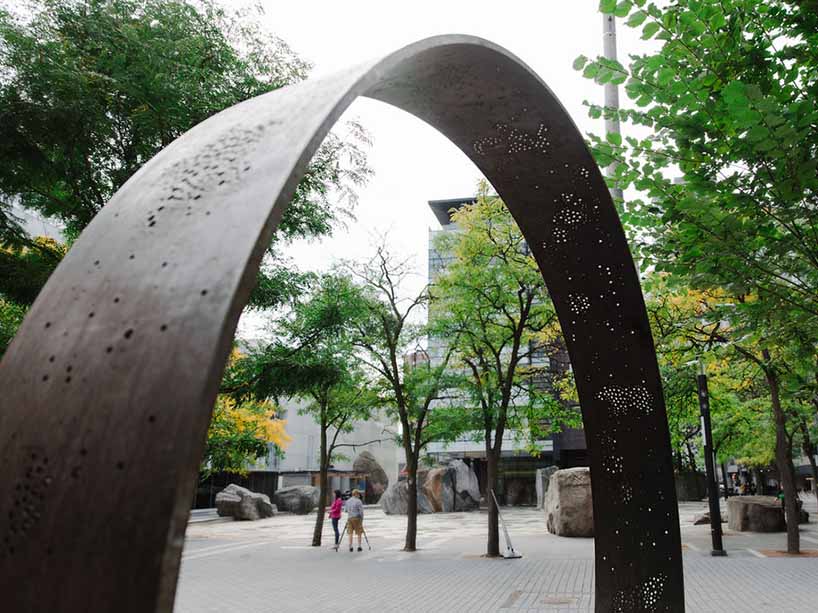
(Photo: Hannah Kiviranta)
Designer
Designed by Matthew Hickey and Jacqueline Daniel of Two Row Architect (external link) and manufactured by Mariani Metal Fabricators (external link) .
Description
A large-scale public artwork colloquially known as the “Ring,” was installed on campus in September 2021, honouring the Dish With One Spoon Territory, the land on which the university is built. The Ring’s graphics incorporate the Seven Grandparent teachings and their animal symbols: Humility, Courage, Honesty, Wisdom, Truth, Respect and Love. Surrounded by stars and the constellation Pleiades, these pictographs also depict the lunar moon phases. The Ring is oriented with the cardinal directions (North, South, East and West) so that the pathway through its opening faces east, representing creation and new beginnings; and west, representing knowledge and wisdom.
Location
Gould St. and Victoria St. (east of the Gould Street and Nelson Mandela Walk intersection).
Acknowledgements
Support for the Ring was made possible by the university and the Lindy Green Family Charitable Foundation.
Learn more
To learn more about the Ring, visit the Facilities Management and Development’s Indigenous Placemaking web page, read the TorontoMet Today story or watch the video Introducing the Ring (external link) .
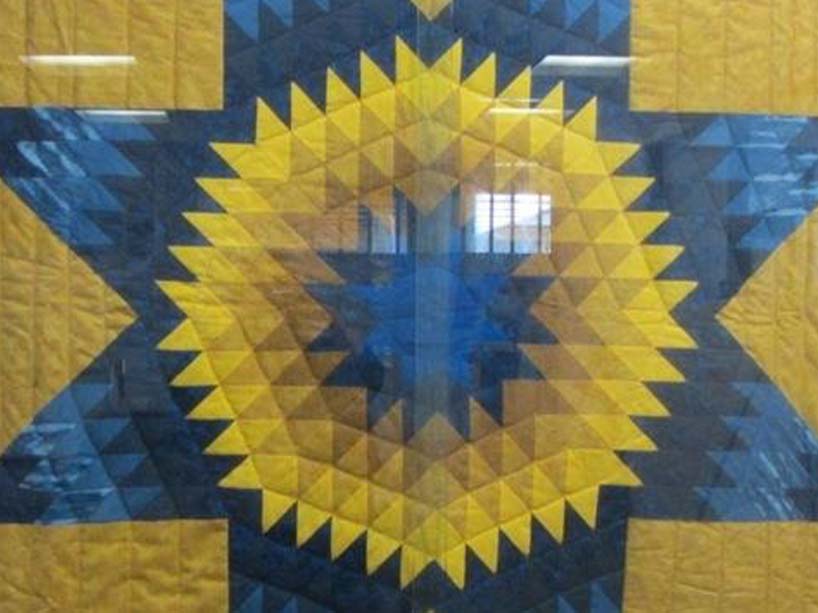
Description
In 2010, the Indigenous Education Council was launched. At launch, they hosted a healing ceremony which acknowledged the role and impact the university’s former namesake, Egerton Ryerson, had on the Indian Residential School policy. In 2013, the council gifted the university with a Star Blanket, to mark the beginning of a new relationship between the university and the Indigenous community of Toronto.
Location
Jorgenson Hall entrance.
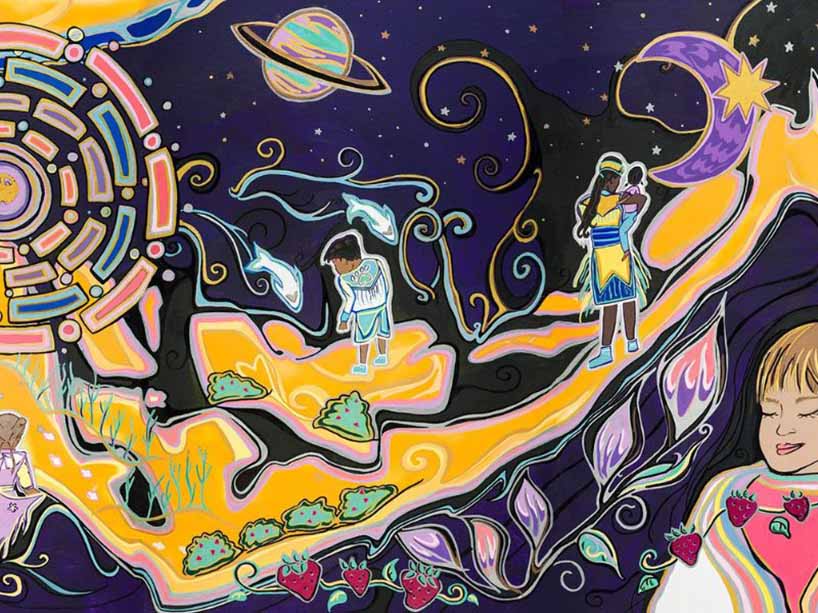
Artist
Miranda Black, Haudenosaunee visual artist.
Description
Unfettered Access for our Grandchildren was conceived during conversations with an Indigenous Knowledge Holder when conducting interviews for Black’s master’s thesis about Indigenous relationships to Toronto Island. One Knowledge Keeper said that their dream for the future of Toronto Island was for their grandchildren to have unfettered access to Toronto Island, “I want him to have access to his rice. Unfettered access to rice and unfettered access to salmon. All the things that everybody else has enjoyed at his expense.”
Location
Active Learning Classroom, Kerr Hall West 057. The Active Learning Classroom is available for both course-based teaching and event bookings by request.
Acknowledgements
This project was made possible by the Teaching and Learning Space Working Group, the Active Learning Classroom Subcommittee, the Call for Emerging Indigenous Artist Adjudication Committee, the Indigenous Space Sub-Working Group, the many contributors to the Community Consultations on Design Standards for Indigenous Learning Spaces, and to the staff of the Centre for Excellence in Learning and Teaching and Facilities Management and Development.
Learn more
Learn more about the Active Learning Classroom Mural.
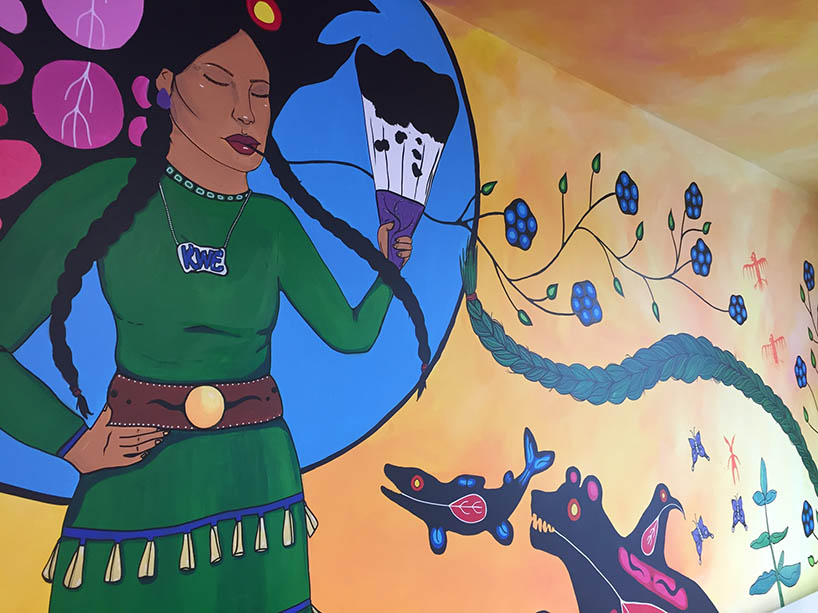
Artist
Chief Lady Bird (Nancy King), Rama First Nation.
Description
This art piece unites meaningful elements from consultation between the artist and the community: a jingle dress symbolizes healing and resilience; woodland designs portray ancestral memory; rocks signify the grandfathers; moon and bearberry honour the grandmother and earth's gifts; birch trees highlight ancestral traditions; interconnected bear, fish and birds evoke unity and clans; seven flowers illustrate Grandfather Teachings; sweetgrass invokes spirits thrice over; stars symbolize ancestors; bird petroglyphs honor heritage; sage lingers; unseen side panels hold cedar, tobacco, butterflies and creatures.
Location
Daphne Cockwell Complex (DCC) 7th floor, Interdisciplinary Graduate Student Space. Contact Leslie Mutic, l2mutic@torontomu.ca, Student Engagement Officer, YSGPS.
Acknowledgements
This piece was commissioned by the Yeates School of Graduate and Postdoctoral Studies (YSGPS).
Learn more
To learn more about the mural, read about it in this TorontoMet Today article.